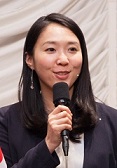Active Learning: Dramatic Changes that Unfold at School Education
February 7, 2018
Ms. Eriko Tokuno
Vice President, Active Learning Inc.
�� Traditional education in Japan has centered around ��passive learning�� where students absorb information and knowledge taught by teachers through a one-directional lecture. Today ��active learning�� is becoming more prevalent where students are encouraged to think and express their thoughts. Mr. Takuya Hane established our company 20 years ago, after teaching at different universities in the U.S.A. including Harvard University and mastering himself the method of active learning. Being an educational business, our clients were mainly schools in the beginning and have diversified over time to range from larger corporations to small-scale startups.
Traditional education in Japan has centered around ��passive learning�� where students absorb information and knowledge taught by teachers through a one-directional lecture. Today ��active learning�� is becoming more prevalent where students are encouraged to think and express their thoughts. Mr. Takuya Hane established our company 20 years ago, after teaching at different universities in the U.S.A. including Harvard University and mastering himself the method of active learning. Being an educational business, our clients were mainly schools in the beginning and have diversified over time to range from larger corporations to small-scale startups.
��In 2020, the National Center Test for University Admissions will be replaced by a new essay-type of examinations that will assess the powers of thinking, judgment and expression. Educational reform unfolds to meet the needs of the times that emphasize innovative ideas and creative thinking. Against this backdrop, active learning will come to play an instrumental role in nurturing individuals who can come up with truly novel solutions by going beyond the boundaries of conventional thinking.
��Now I must emphasize that passive learning is also important because students must absorb the basic knowledge of literacy and numeracy as the fundamental basis on which education is grounded. What is important is to balance out the ��input�� and ��output�� to encourage students to actively construct knowledge and demonstrate externalized output.
��The human brain has numerous nerve cells called the neurons which pass chemical and electrical signals to process, transmit and store information along the pathways. Interesting enough, research findings prove that passive learning results in weaker connection between neurons whereas active learning leads to deeply embedded neural connections. We named the moment when our brain is most active ��kainō (brain-opening)�� attained when the learners feel they are in command of their learning. We can find similar phenomena in our daily life, including the so-called ��drivers�� effect. It is often said that people in the driver��s seat remember the route better than those in the passenger seat because the latter often fails to stay concentrated and agile. Now it becomes a serious educational issue when learners turn into passive recipients of information, just like people feeling a little lazy in the passenger seat. Likewise at our home or office, as parents or supervisors get an upper hand, children or subordinates tend to become passive and sometimes apathetic. To solve such situations, we need to switch seats and make the learners take the wheel so that they become proactive quick learners with maximum comprehension and information-intake. Feedbacks from our clients prove that active learning can actually improve academic performance at schools.
��Now what impact will active learning bring on business communities? Active learning was first introduced into some schools 8 years ago and an increasing number of graduates are entering the job market. Companies must change their recruitment and hiring process to attract proactive candidates. Companies used to hold joint job fairs and provide company information one-sidedly. Today, more and more companies are organizing events where students participate on their own initiative. For example, a housing and real-estate company LIFULL invites students to draft a business plan and make proposals to entrepreneurs. Such a proactive attitude ranked the company top on the ��Best Workplaces in Asia List��. Companies must also change their method of cultivating human resources. Reports show that the conventional top-down method has become ineffective and an increasing number of companies are providing training sessions for the management on new ways to motivate and stimulate staff members.
��Our company has conducted a survey with young people around the world. We asked the three most important things in their life and interestingly enough, ��family and friends�� were always among the answers in all countries around the world. Japanese students tend to give familiar set of answers while American students try to make a comment from their unique perspective. The first idea which comes to our mind is often derived from our knowledge and experience compiled over years. In other words, it is more ��retrieving�� than ��thinking��. I can say to ��think�� is to add one��s original or new idea to the information retrieved. I believe we can stimulate innovation and creativity only when we go beyond our first inspirational idea and elaborate on our second or third thoughts. We need to cultivate human resources capable of taking the two steps of ��searching or retrieving�� and ��thinking��.
��Before I close my speech, let me share with you a quick active learning method that can be used at home every day. Simply by changing our communication style, we can make learners a proactive ��driver behind the wheel��. I am sure not a few parents tend to speak in a commanding tone to their children. It would be more effective to encourage children to express their thoughts and opinion, by asking them what they think and what can happen afterwards and inviting them into a dialogue. We offer camps for children and courses instructed by students of Harvard University. We would be happy to support those who wish to make their communication style more proactive and effective. Thank you.